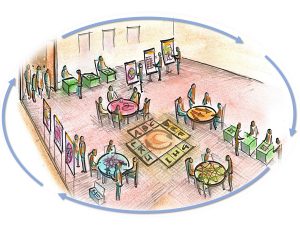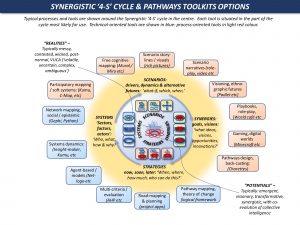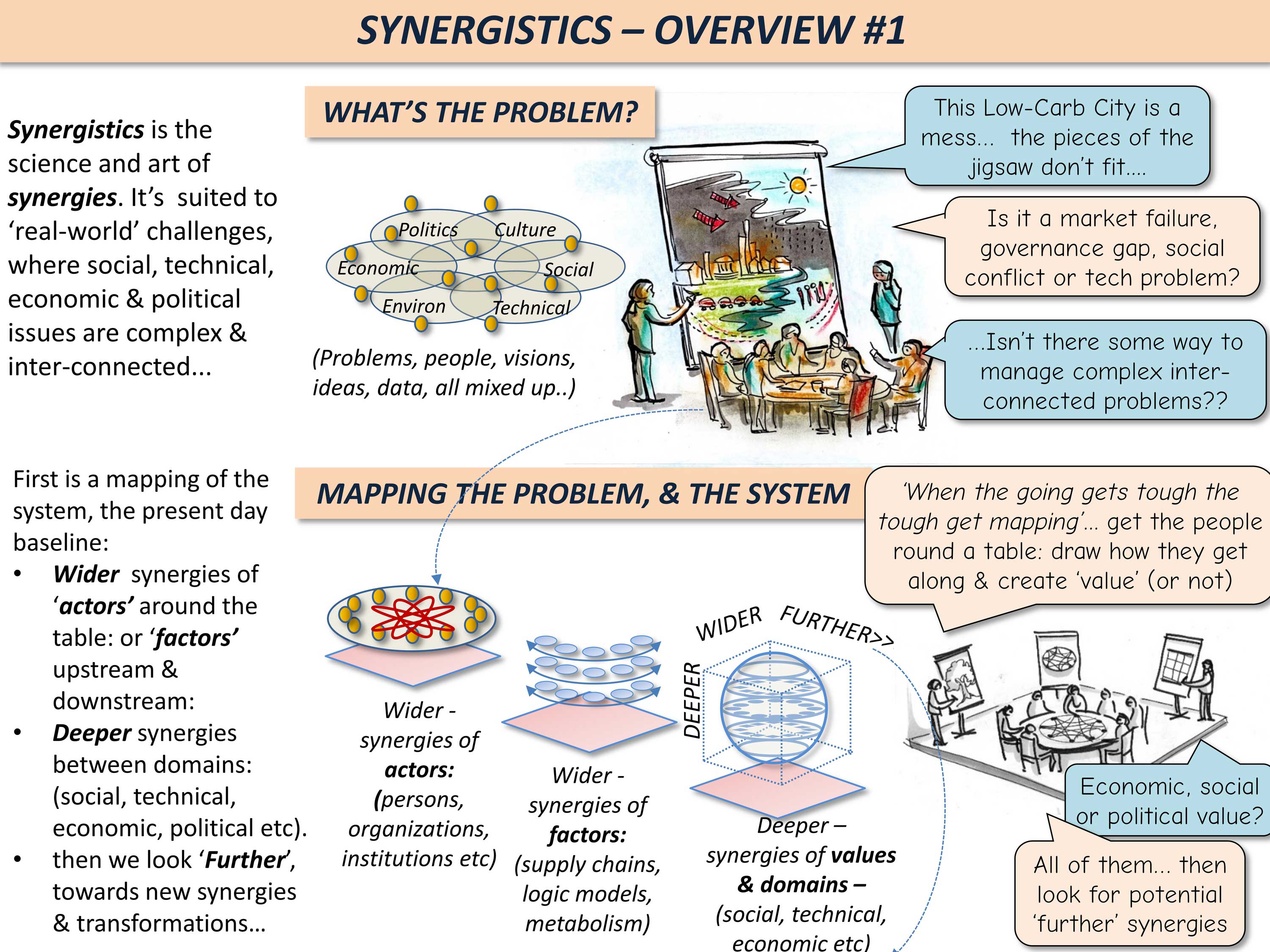Synergistic Pathway Toolkits
The ‘grand challenges’ of this 21st century can seem over-whelming – war, inequality, ecological self-destruction and digital mass psychosis. In each of these we need to look beyond short term problem-fixing, towards longer term transformation. In each of these the fundamental agenda is about the potential for collective intelligence – i.e. shared learning, innovation and collaboration – between people, organizations, businesses, governments, communities & cultures.
The Pathway Toolkits are a suite of tools and techniques, based on a common structure. Each toolkit can help in some way with the mapping of such challenges, and the design of pathways towards synergy and collective intelligence. Each has been developed and tested for some decades in many projects in many countries.
From experience we find that four very basic questions are enough to start a process of creative thinking: (the time horizons may be anything from 1 year to 100 years, depending on the issue) –
- What are the ‘Top 3 challenges’ in the current situation ??
- How are things changing – the ‘Top 3 changes’ in the future??
- What is the potential – the ‘Top 3 visions / opportunities’ which point forwards??
- How to achieve them – the ‘Top 3 priorities’ for planning and action ??
Starting with such simple questions, supported by visual thinking templates, we can explore and map the pathways. These are broad directions for change & transformation in any complex system – social, technical, economic, ecological, political, cultural / mythological. Pathways are not fixed plans – they are more like flexible and creative ways to mobilize the synergies between all stakeholders, from the near future to the further ‘horizon 3’. Each pathway aims to connect –
– “REALITIES” – Typically messy, contested, wicked, post-normal, VUCA (‘volatile, uncertain, complex, ambiguous’), with
– “POTENTIALS” – Typically emergent, visionary, transformative, synergistic, with co-evolution of collective intelligence

How does this look in practice?
We can see room of dialogue, shared learning and emerging collective intelligence – i.e. a Collaboratorium. With a structured process any group can explore their problems, map the future, envision the opportunities and mobilize the actions…
The Pathway Toolkits are based on the principles of synergistics and co-evolutionary collective intelligence, with a wider community of interest, deeper layers of value, and further horizons of transformation (see below).
Synergistics – the art and science of synergies – looks for such transformations in all walks of life – social, technical, economic, environmental, political, cultural etc.
For an intro to the synergistic approach see the Synergistics – overview.
Pathway toolkit options
The Pathway Toolkits come in many forms, depending on who is thinking about pathways, how they can best do this, and for what purpose.
The diagram here shows typical processes and tools around the Synergistic ‘4-S’ cycle in the centre. This cycle provides a structured process to explore the 4 key questions above: –
- ‘Top 3 challenges’ : SYSTEMS, ‘Sectors, factors, actors’: ‘Who, what, how & why?
- ‘Top 3 changes’: SCENARIOS: drivers, dynamics & alternative futures: ‘what-if, which, when,’
- ‘Top 3 visions’: SYNERGIES: goals, visions: ‘what ideas, visions, opportunities, innovations?’
- ‘Top 3 priorities’ : STRATEGIES: now, soon, later: ‘When, where, how much, who can do this?’
Each of these 4 sections has a set of visual templates for mapping & design of systems and ideas – these are explained in the toolkits section below.
Surrounding this circle is a range of tools. Each is situated in the part of the cycle most likely for use. Technical-oriented tools are shown in blue: social process-oriented tools in light red colour.

Each of these toolkits is in some way is a balance between fuzzy controversial challenges (typical of real life human problems), and the technical analysis or modelling which can inform them.
As a first step, whiteboards offer about the best balance between more unstructured creative thinking, and enough analytic functions to take this forward. On-site F2F whiteboards can quickly sketch the visual templates for each stage. As the Covid-19 came with a rapid shift to online, we developed a Pathways toolkit in a highly structured series of Mural whiteboards, now tested in many projects since 2020.
These can link directly with technical tools and platforms, as and where this is useful: we have experimented with system level tools such as Kumu, Decision Explorer, Insightmaker: management-focused tools such as Padlet, Trello, C-Map: and network mapping tools such as Gephi or NodeXL.
Meanwhile, different types of users / clients, may have different agendas. Very broadly, research agendas focus on some kind of evidence-based knowledge: policy agendas on management: enterprise agendas on practical action: and societal agendas focus more on meaning and value. Each agenda calls for a different suite of tools, from creative thinking to data analysis.
Pathway toolkit examples
- Synergistic / Pathways mapping & design: this is the basic approach, in 4 main stages, as detailed below. This works best as a F2F process with creative thinking around working group tables of 3-6 participants. For online meetings we developed, through the Covid period, a large workspace on the Mural platform, with a series of templates based on the synergistic approach. Experience shows this needs dedicated and focused attention by participants: F2F this takes at least 2 hours: online takes more, subject to the commitment of the participants. Possibly the most effective examples are seen with students, where time is less pressured. A fully specified workshop, moving in detail from problems to pathways, with 20-40 participants, takes up to 2 days (see example of Low Carbon Qatar).
- Pathways Playbooks can make the process easy and fun for users – taking the basic ideas as a play-book of examples, maps, stories and pictures. The basic playbook (in ppt format) can be adapted to almost any issue, by selecting the pages needed, and inserting the case study materials (pictures, stories, maps, links etc). This can be printed out for F2F discussion, or mounted online for virtual meetings. Examples include the Ground Zone: see the Pathways Playbook page for more resources.
- Pathways Role-play was the theme of experimentation at the COP26 in 2021, and in follow on projects, such as the Eco-war. It seems to fully explore and understand systemic risks or resilience, we have to role-play or ‘war-game’ the strategies and opportunities of key actors / stakeholders. The background to this is the ‘BBW’ (‘Big Bad World’) approach to understanding predatory expropriation, colonization, hijacking and weaponization, as seen in the Ukraine war & others. Feedback: participants need some preparation for this – or – we need to reframe it more as a ‘game’…
- Visual thinking fits well with the narrative approach to storylines and scenarios. Both can be very effective for creative thinking ‘out-of-the-box’, simulating the role-play of actors, and exploring both visions and nightmares. Cartoons can be edgy and in some cases risky to the funding organizations. Various series are in motion such as the Climate-wise and Political Games on http://www.urban3.net.
Synergistics – practical guides
These Practical Guides are more like working papers with a brief outline of the theme & challenge, and some background material to get a project set up. This can then use any of the options above – simple mapping, role-play design, the Playbook format and others.
Download the Synergistics – a practical guide (older version, updating in progress)
These are various Synergistic Practical Guides / visual briefings on topical themes –
- Synergistics – visual briefing – risk & resilience
- Synergistics – visual briefing – science-technology-foresight
- Synergistics – visual briefing – Smart-Wise Cities
- Synergistics – visual briefing – strategic planning
- Synergistics – visual briefing – zero-carbon cities
- Synergistics – visual briefing – Food & farming
Synergistics: overview of ‘4-S’ process
The Synergistic Pathways Toolkit helps to understand a complex present, and explore the pathways to opportunities in the future. This cycle, from present to future and back, centres on the process tools and their 4 main stages – ‘Systems / scenarios / synergies / strategies’. Explore the four stages: –
- Systems, syndromes & conditions now?
- Scenarios & changes in the future?
- Synergies & transformations in the future?
- Strategies & pathways to create that future starting now?
What is ‘Synergistics’?
We are surrounded by hugely complex inter-connected challenges. Climate change, for example, combines earth science with society, technology, ecology, economics, politics and cultural issues, at global and local levels. How to work with such inter-connected problems?
We use ‘Synergistics’ – practical joined up thinking, for problems / solutions where progress depends on synergy and collective intelligence.

How does it work?
So where to start? With simple drawings or diagrams, on flipcharts or napkins or sticky notes, we can do ‘synergistic mapping’ of people and organizations and systems (‘actors’ and ‘factors’). We use as much detail as needed at each stage, whether technical information or social deliberation. Then we can begin to explore systematically, beyond the normal boundaries and silos:
- Wider, with synergies of actors, and of factors, (people or organizations or institutions).
- Deeper, with synergies between different domains and value systems (social, technical, economic, political etc).
- Further, with synergies emerging, or with potential to emerge.
This further dimension is the key to real progress in turning ‘syndromes’ into ‘synergies’:
- Mode-I, (‘1.0’), mechanical change and ‘clever’ systems: ‘a city as machine’
- Mode-II, (‘2.0’), biological evolution and ‘smart’ systems: ‘a city as jungle’
- Mode-III, (‘3.0’), human co-evolution and ‘wise’ systems: ‘a city as civilization’.
To explore and realize these Mode-III systems, we use a Synergistic Toolkit, in 4-stages:
- System mapping / co-learning: the baseline syndromes and issues on the table:
- Change mapping / co-knowledge: the dynamics of change and alternative futures:
- Synergy mapping / co-creation: design of opportunities, innovations, transformations:
- Pathway mapping / co-production: design of pathways, road-maps, policies, projects:

The Mode-III ‘wise’ ideas combine into a bigger picture of a sustainable and synergistic future. This follows on the question – ‘what if’ we could organize societies, economies, politics etc, around a ‘wiser’ collective intelligence?
To answer this, we need ways to move from ‘problem’ syndromes (generally in Mode-I or II) to ‘solution’ synergies (generally in Mode-III). So we design for the ‘synergistic pathways from smart to wise’…
